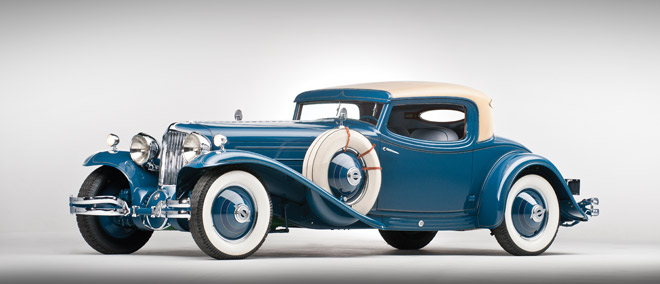The fast rise and eventual collapse of E.L. Cord’s massive industrial empire, with the Auburn, Cord and Duesenberg marques at its core, remains one of corporate America’s most fascinating and tragic stories. From the dramatic turnaround of Auburn in the mid-1920s, which is a textbook case of selective marketing, Cord’s companies manufactured and sold some of the most innovative, stylish and value-rich automobiles ever conceived.
The L-29 Front Drive Cord was developed as a new, medium-priced car with innovative engineering and distinctive styling. The long drivetrain package, necessitated by the L-29’s inline 8-cylinder and front-wheel-drive system, became one of the car’s greatest assets when designer Al Leamy sketched one of the longest hoods ever seen.
American and European custom coachbuilders naturally gravitated to the design possibilities of the low-slung L-29 chassis, and 43 custom-bodied L-29s were created. Just 12 are known to remain in existence today, including the singular and stunning Hayes coupe offered by RM.
SCM Analysis
Detailing
| Vehicle: | 1929 Cord L-29 Special coupe |
This car, Lot 132, sold for $2,420,000, including buyer’s premium, at RM’s Amelia Island Auction on March 10, 2012.
This spectacular, one-off car was the collaboration of three distinct automotive elements: the Cord L-29, Count Alexis de Sakhnoffsky and the Hayes Body Corporation. In 1927, E.L. Cord went against conventional wisdom and decided to pursue the idea of propelling an automobile by its front wheels. This was not a new idea, as a multitude of others had unsuccessfully traveled that path, but Cord — who believed that if you can’t be big you had to be different — willed the project to fruition.
The genesis for the successful front-wheel drive was found with Harry Miller, as he proposed the technology for a race car in 1923. By the late 1920s, the most prominent drivers were steering his front-wheel-drive race cars.
Cord hired Miller to assist in the L-29 development, although the design, patented by Cornelius Van Ranst and Tommy Milton, was more evident in the final product. Production of the L-29 began in June of 1929, and the low frame height and long hood offered an exciting platform for custom coachwork.
An unlikely — yet perfect — coachbuilder
Fewer than 50 L-29 chassis were fitted with custom bodies by American and European coachbuilders. The Walter Murphy Company of Pasadena, CA, built several dual-cowl phaetons — and at least four town cars were built on an extended-wheelbase chassis. One of the most striking custom bodies was a speedster that was built by the Union Body Company based on a design by Phil Wright. After being shown at the Concours d’Elegance Femina l’Luter in Paris, it was returned to the United States and soon disappeared.
The Hayes Body Company of Grand Rapids, MI, was the least likely coachbuilder to produce the stunning L-29 Special Coupe. The company, under any number of corporate entities, supplied fenders for Ford Model Ts — as well as Oldsmobile bodies and other sub-assemblies. During the mid-1920s, Hayes employed more than 3,000 workers and produced 120,000 bodies annually for companies including Chevrolet, Maxwell, Paige, Reo and Willys-Overland.
Hayes employed a number of talented designers, and the most well-known was Count Alexis de Sakhnoffsky, who joined the firm in 1928. He had previously worked for Vanden Plas of Brussels and had won awards at the Monaco Concours d’Elegance.
Sakhnoffsky’s vision made the L-29 Special Coupe an exceptional car — one that had little in common with Model Ts, Chevrolets or Reos.
Some accounts claim he built the L-29 Special Coupe as his personal car, while others state it was built as an American entry for the 1929 Monaco Concours.
Regardless, Sakhnoffsky’s radical and graceful design extended the hood seven inches, and the height was only 54 inches — six lower than production models. The car, which features the long, low hood, graceful window openings and no running boards, was completed in only two months and cost between $15,000 and $20,000 to build. The Cord won the Gran Prix at Monaco’s 1929 Concours d’Elegance and d’Hommeur at the Beaulieu Concours — the only American car to ever do so.
Buying for the future?
The car was in the care of noted industrial designer Brook Stevens for five decades, and he restored the car for entry into the Custom-Bodied Cord Class at the 1987 Pebble Beach Concours d’Elegance, where it won its class. Gooding & Company subsequently offered the car at their August 17, 2008, Pebble Beach auction, where it realized $1,078,000.
Is this L-29 Cord really worth more than double its 2008 selling price in just four short years? Well, that was then, and we are now in a much different economic environment. Automobiles of this stature are commanding record prices — as the rare, elegant and fully documented are appreciated for their art form as well as being a weapons-grade investment.
This car was obviously well sold, but what about the buyer? We’ll hedge our comments and rely on the adage: “He did not pay too much, just bought a little too soon.”
